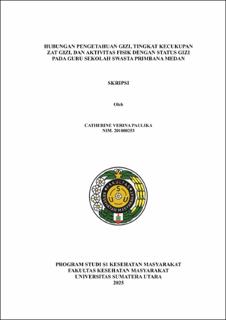| dc.contributor.advisor | Aritonang, Evawany Yunita | |
| dc.contributor.author | Paulika, Catherine Verina | |
| dc.date.accessioned | 2025-05-02T04:29:30Z | |
| dc.date.available | 2025-05-02T04:29:30Z | |
| dc.date.issued | 2025 | |
| dc.identifier.uri | https://repositori.usu.ac.id/handle/123456789/103561 | |
| dc.description.abstract | A person's health condition can be assessed through their nutritional status, determined by the balance between nutrient intake from food and the nutrient requirements for the body's metabolism. Nutrient intake plays a crucial role in determining nutritional status and activity levels, including for teachers. Nutritional knowledge influences attitudes and behaviors in food selection, impacting an individual's nutritional condition. Both nutrient intake and physical activity are essential for achieving a normal nutritional status; when balanced, good nutritional status can enhance work productivity. This study aims to determine the relationship between nutritional knowledge, nutrient adequacy levels, and physical activity with nutritional status among teachers at Primbana Private School in Medan. The research was conducted quantitatively with a cross-sectional design involving 59 teachers. The Spearman Rank test was used to analyze the relationships. Nutritional knowledge was measured through questionnaires, nutrient adequacy levels were assessed via food recall interviews and Nutrisurvey, and physical activity was measured using the Physical Activity Level (PAL) questionnaire. The results showed that 30 (50.8%) teachers had an obese nutritional status, 17 (11.9%) had a normal status, and 12 (20.3%) were overweight. Statistical tests indicated a significant relationship between nutritional knowledge and nutritional status, with a p-value of 0.010. However, no relationship was found between nutrient adequacy levels and nutritional status, with p-values of 0.279 for energy, 0.436 for protein, 0.426 for fat, and 0.877 for carbohydrates. Additionally, no relationship was found between physical activity and nutritional status on school days (p-value = 0.101) and holidays (p-value = 0.095). Recommendations include providing nutritious food at school and conducting regular health check-ups for teachers. Teachers are advised to apply good nutritional principles and integrate physical activity into their daily routines. | en_US |
| dc.language.iso | id | en_US |
| dc.publisher | Universitas Sumatera Utara | en_US |
| dc.subject | Nutritional status | en_US |
| dc.subject | Teachers | en_US |
| dc.subject | Nutritional knowledge | en_US |
| dc.title | Hubungan Pengetahuan Gizi, Tingkat Kecukupan Zat Gizi, dan Aktivitas Fisik dengan Status Gizi pada Guru Sekolah Swasta Primbana Medan | en_US |
| dc.title.alternative | The Relationship of Nutritional Knowledge, Nutrient Adequacy Levels, and Physical Activity with Nutritional Status among Teachers at Primbana Private School in Medan | en_US |
| dc.type | Thesis | en_US |
| dc.identifier.nim | NIM201000253 | |
| dc.identifier.nidn | NIDN0016056809 | |
| dc.identifier.kodeprodi | KODEPRODI13201#Kesehatan Masyarakat | |
| dc.description.pages | 125 Pages | en_US |
| dc.description.type | Skripsi Sarjana | en_US |
| dc.subject.sdgs | SDGs 3. Good Health And Well Being | en_US |


